Installing Window Shutters Cost
Last updated 2nd September, 2024
Introducing window shutters in your home can be transformative. From adding functional privacy-bearing benefits to sophisticated aesthetics, window shutters are becoming an increasingly popular option for homeowners.
So, how much do shutters cost?
The average cost for window shutter installation is around £250 per m2
In this article, we’ll answer that and look at the different materials, wood, vinyl, and aluminium, as well as the different shutter styles, plantation, solid, and café style, to help you find the best match for your needs.
Let’s get into it.
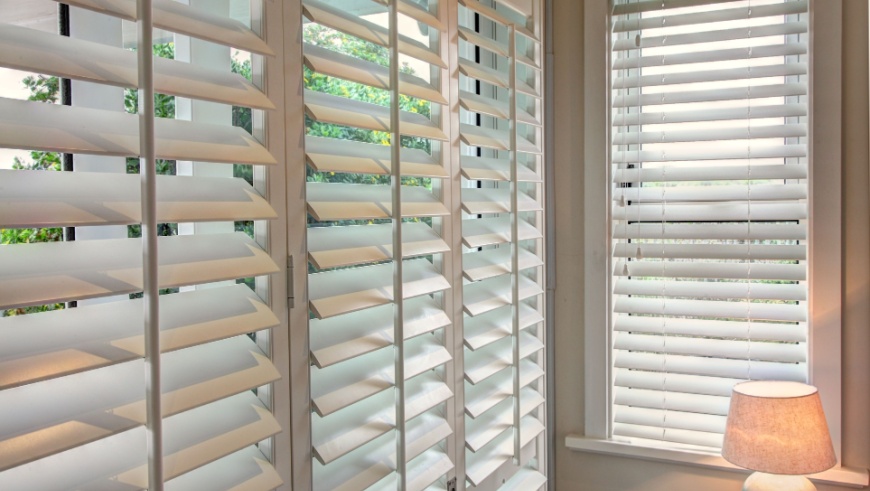
Table of Contents
How Much Do Window Shutters Cost?
While window shutters are perhaps known for their high initial cost, they do bear a good return on investment as they can act as appealing features to potential homeowners, helping to boost your property’s value due to their bespoke nature. Window shutters can also benefit your home’s insulation, helping to keep the warm air in when it's cold outside.
The average cost for window shutter installation is around £250 per m2. The average cost of shutters for a 3 bedroom house is around £2,500 to £5,000, depending on the installation.
There are nuances shutters for windows costs, however, depending on a few factors:
Interior vs Exterior Window Shutters
Whether your window shutters are internal or external will affect the price you’ll pay for their supply and installation. For instance, interior plantation shutters cost between £180 to £300 per m2, while exterior shutters can be anywhere from £160 to £360 per m2.
Window Shutter Material
The more premium the material, the higher the price–UPVC is the most affordable option, while composite and luxury natural woods can be more expensive.
Bespoke vs Off-the-shelf Window Shutter Sizes
As you’d expect, you’ll pay more for bespoke, custom-made sizes than you would off-the-shelf sizes. Bay windows are particularly common when it comes to commanding high prices, as they usually feature large drops and vast widths that aren’t usually catered for with regular off-the-shelf sizes.
The extra work involved in creating the larger, bespoke sizes will translate into higher prices for your supply and installation. Due to their size and scale, the larger the shutters, the more likely you’ll need professional fitting.
Number of Windows/Number of Window Shutters
You’ve guessed it–the more windows you have in your home, the higher your window shutter supply and installation costs will be. As with all home renovation projects, the more vast the scope, the higher the price is likely to be.
Similar to the last point, if you have a particularly large window expanse and need bespoke sizes created for most, if not all, of your windows, expect your prices to be far higher than those in smaller properties with more standardised window sizes.
Now that we’ve identified the influencing factors, let’s examine some sample window shutter installation prices.
Window Shutter Installation Prices
Here are some representative cost estimates for various styles of interior and exterior window shutters:
| Type of Shutter | Total Estimated Cost |
|---|---|
| Plantation shutter (supply and installation) | £180 to £300 per m2 |
| Wood shutter (supply and installation) | £50 to £300 per m2 |
| Bay window shutter (supply and installation) | £360 to £720 per m2 |
| Garage roller shutter (supply and installation) | £600 to £4,000 |
| Shutter cost only (supply) | £150 to £300 per m2 |
Plantation shutters are popular choices due to their timeless style and aesthetic. For supply and installation, you’ll be looking at costs between £180 to £300 per m2, depending on the material you choose. Wood shutters can be fairly cost-effective depending on the wood, starting at £50 and rising to £300 per m2.
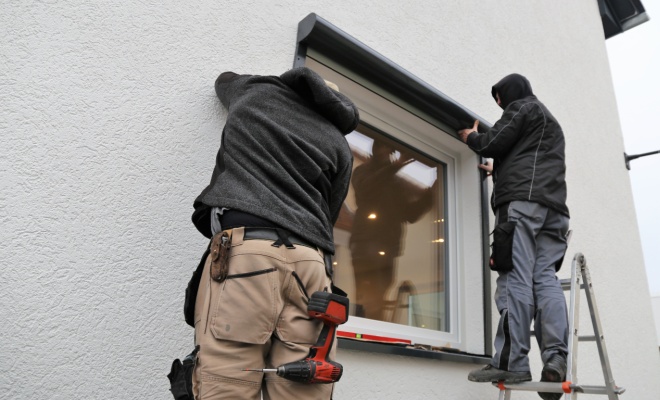
Bay windows are tricky to install due to their size and configuration and usually cost around £360 to £720 per m2. Looking externally now, garage roller shutters can command costs of £600 to £4,000 for supply and installation, depending on the exact materials and functionality.
Let’s now take a look at some specific shutter styles and their associated supply costs:
| Type of Shutter | Supply Cost Only |
|---|---|
| Full-height shutter | From £204 per m2 |
| Tier-on-tier shutter | From £204 per m2 |
| Café-style shutter | From £204 per m2 |
| Solid shutter | From £224 per m2 |
Full-height, tier-on-tier, and café-style shutters all have the same starting supply only cost of £204 per m2, while solid shutters are slightly more expensive at £224 per m2 due to the increase in materials used.
Additional Costs
There are a range of additional costs that might crop up while you’re arranging for your window shutter project. Let’s take a look at a few of them so you’re clued up when the time comes:
Replacement Windows
It’s a big one–if you’re having new window shutters installed, you might want to consider the state of your actual windows before carrying out the work. If they’ve seen better days and are letting in lots of moisture or have near-constant condensation, you might want to replace the windows before continuing.
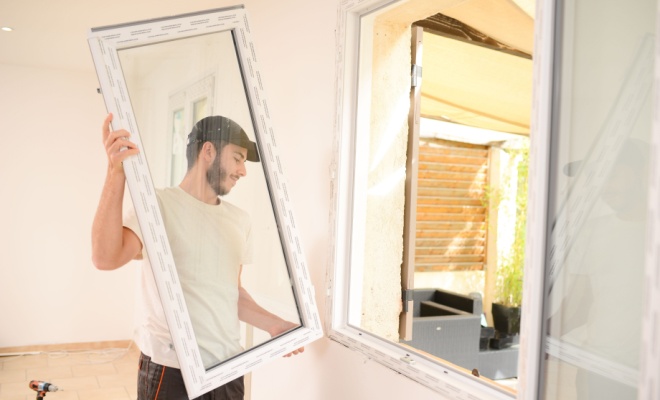
Depending on the size of your windows and the volume you need to change in your home, costs can range from £4,000 to £5,000 for an average semi-detached house (eight windows, two doors), or around £200 to £400 per UPVC casement window.
Re-plastering
Continuing with the larger jobs, if you’ve had your windows replaced, you might look at the rest of your room and wonder if it needs decorating–or if it actually needs re-plastering. If you’ve had an issue with moisture in your home or have had damp problems that have been recently fixed, you may need to re-plaster to get your walls back to their original state.
Re-plastering a small room can cost anywhere from £390 to £500, while a large room can command prices closer to £550 to £700. If you can get away with patch repairs instead, these are around £70 to £130.
Painting and Decorating
Once re-plastering has taken place, the next job is up–painting and decorating. If it’s simple painting onto a freshly plastered wall, this will cost around £250 and take around 4 to 8 hours, depending on the room’s size.
If you haven’t had to re-plaster but do need the old wallpaper stripping, this will cost slightly more, at £350. If your room’s woodwork also needs a refresh, this will bump the decorating costs up to around £500.
This is an area where you can trim your costs, as you can paint and decorate–and even plaster a room–yourself if you have the tools, equipment, and willingness to do so.
Cost Breakdown Calculator
The total cost for supply and installation of window shutters in an average 3 bedroom house: £2,500
Supply:
£2,000
Labour:
£500
Waste Removal:
£0
Labour Costs and Time Frames
If you buy your window shutters from a company that offers both the manufacture and installation of shutters, your labour costs are likely to be rolled into your total estimated cost. However, if you are unsure about this, make sure you check in with your chosen company to ensure this is the case, as unexpected costs when it comes to settling up are never wanted.
Timeframes vary depending on the size of your property, the number of windows and shutters, and the size of the window recesses. Also, the type of shutter you choose will affect how long the installation takes, as some may come ready-made (such as solid window shutters), whereas others might need individual installation.
The accessibility of your windows is also something to consider when determining labour timeframes. If your windows are particularly high, vast, or at hard-to-reach locations (such as over large staircases, for example), the labour charges are likely to be higher than those for easy-to-reach windows with standard sizes.
You can expect to pay between £150 and £300 for window shutter installation, which can take anywhere from a few hours to a full day or more for more complex installations.
Type of Window Shutters
There are many types of window shutters to choose from!
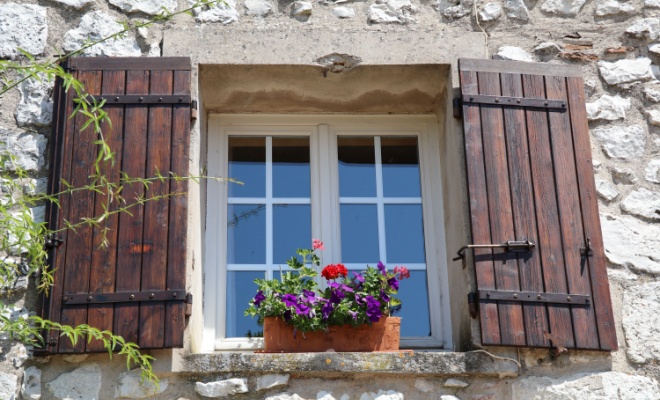
Let’s take a closer look at some of the key advantages and disadvantages associated with the different styles of window shutters:
| Type | Advantages | Disadvantages |
|---|---|---|
| Full-height shutter | One single unit from top to bottom, covering the entire window, offering great privacy | Only operates as one solid unit, with less flexibility than other shutter designs |
| Tier-on-tier shutter | Available in upper and lower sections, these can be opened independently to give great flexibility, keeping the lower half closed while the top layer is open to let light in while maintaining privacy | More expensive than full-height shutters due to the extra mechanisms involved |
| Café-style shutter | Just on the lower half of the window, café style shutters give great privacy while keeping all the light beyond the halfway point | The reverse of the advantage is true: there's only privacy to the bottom half of your window, meaning the top is left exposed |
| Solid shutter | Much like the full-height shutter, solid shutters have completely solid sections that run from the top to the bottom of the window, acting much like solid curtains | Little light control as the whole panel is attached, meaning they're either "on" or "off" |
As we’ve found by now, there’s literally no one-size-fits-all when it comes to window shutters. Let’s consider the advantages and disadvantages of the different material types, too:
| Material | Advantages | Disadvantages |
|---|---|---|
| UPVC | Cheap to install and manufacture, weather resistant, lightweight, easy to maintain | UPVC can look cheaper than natural wood or metal and doesn't carry the same timeless look as natural materials |
| Natural Wood | Natural, characterful, with a timeless appeal. Strong and easy to clean, can be customised with stains or paints | Typically more expensive than UPVC, regular maintenance is required, can be prone to warping if exposed to moisture, can become weathered over time and change colour due to sun bleaching |
| Composite Wood | Composite gives a similar look to natural wood but is more durable and water-resistant, won't warp or change colour in sunlight, and is lightweight and easy to clean | However, composite wood can look cheap up close, and the composite covering may chip over time which will compromise the faux-wood effect |
| Aluminium | Weather resistant, easy to maintain, strong yet lightweight | Aluminium shutters don't have the same traditional appeal as wood, being more suited to office or more corporate environments |
| Vinyl | Moisture resistant, minimal maintenance, won't warp or fade and are more affordable than natural wood shutters | Not as strong as other window shutter materials, and they’re not possible to paint or stain like you could with wood, for example |
Installation Steps
Now, let’s take a look at the steps your window shutter installer will take when getting your new window fixtures up and running:
- Measurements
The first step will be for you or your window shutter installer to take measurements of your chosen windows. These measurements will differ depending on the style of shutter you’ve opted for and will be checked a few times to ensure they’re correct before moving ahead to order the bespoke size. - Assembling the Shutter Frame
The shutter’s frame will be assembled first, ready for fixing into the window recess. This will be done before the frame is installed into the window. - Raising Shutter Frame into Position
The installer will then raise the shutter frame into the window’s recess. Depending on where the frame holes are, the installer will make marks on the recess to line them up before starting to drill the screws into the wall to hold the frame in place. - Hanging the Panels
Once the frame is securely in position, the fitter will move on to hanging the panels. This stage will look different depending on the type of window shutter you’ve chosen, but the installer will follow a set of instructions tailored to the exact type to make sure they’re fitted correctly–to do this, the panels will be adjusted to ensure a correct, flush finish. - Finishing Off and Making Good
When the panels are secured, the installer will move on to some final making good steps. Caulk will be used to smooth over edges where necessary (and requested), while any slats will be adjusted to ensure a good level of tension. The shutters will be tested to ensure they work, and any adjustments will be made at this stage before the installer finishes their work.
DIY Installation
It is possible to DIY install some types of window shutters if you feel capable of doing so and have the necessary tools–but for larger installations, it is best to get the help of a professional window shutter fitter to ensure the job is done correctly.
In most cases, you’ll be able to order the shutters yourself by supplying your own measurements. Shutter companies do offer at-home measurement services if you are not comfortable with this, but they do usually come at an extra cost, so if you’re happy to do this yourself it’s a good way of trimming some costs off your project.
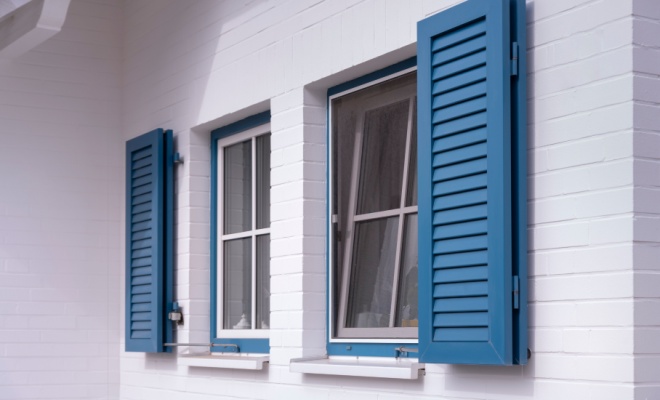
As the window shutters will have been manufactured to your bespoke window size, they may be damaged if installed incorrectly. This isn’t a cheap issue to fix, and for this reason, it’s usually recommended that you opt for a professional fitting to mitigate this potential issue.
For peace of mind, it’s recommended that you hire a professional window shutter fitter to do the job quickly and easily and ensure the window fixtures are installed safely and properly.
Compliance and Regulations
Internal window shutters are unlikely to carry too many rules and regulations on their fitting if you live in a modern house. However, for listed buildings or those in restrictive covenants, the rules may differ, and you might not be permitted to install shutters.
In these instances, it’s best to check on an individual basis to find out what’s permitted in your area. Similarly, if you are considering external shutters, you may not be permitted if you’re in a listed building as you are unlikely to be able to change the outer facade of the building without permission.
The rules may be different if you are replacing like-for-like shutters, but you will still need to check this with your local council to ensure you’re abiding by the rules and won’t be subject to any fines if you carry out the work without prior permission.
FAQs
You should also consider your home’s architecture to establish the best choice for you. Vast bay windows will be more expensive than standard-sized windows, so if you’re on a tight budget, opting for UPVC would be a more cost-effective option than natural wood, for example.
Finding and Hiring a Professional
While some window shutters are DIY-friendly, others are not–such as large installations in bay windows, for example. In these instances, it’s best to hire professional window shutter fitters to ensure a thorough, accurate job.
Most window shutter manufacturers will offer an installation service as part of their sales pitch, but they are typically quite marked-up so you may end up paying more than you would with an independent fitter, for example.
It’s prudent to gather at least three quotes from different contractors to get an idea of the range of prices and the market average for your job. Be especially wary of any prices that come in drastically lower than the others, or have an incredibly quick timeframe attached to them, as the trader might not be as trustworthy as others.
Make sure you take a look at the trader’s portfolio of past work, paying close attention to any photos or videos of their past installations to get a feel for their standard of work. If you have a particularly tricky installation, it’s best to find a fitter who demonstrates experience in this type of window–someone who is great at standard window fittings may not be as good at intricate bay window installations.
Lastly, be sure to enquire about any warranties or guarantees the fitter has for their work. If something fails soon after being installed, it’s good to know if the trader will cover it or if you’ll have to pay for it as a separate service.
Sources
https://shutters.co.uk/new-to-shutters/why-choose-us/how-much-do-wooden-window-shutters-cost
https://www.diyshutters.co.uk/about-us/blog/july-2021/how-much-do-bay-window-shutters-cost
https://www.thomas-sanderson.co.uk/inspiration/what-are-the-different-types-of-shutters
https://shutters.co.uk/new-to-shutters/why-choose-us/how-much-do-wooden-window-shutters-cost
https://www.shutterlux.ca/blog/window-shutters-pros-and-cons
https://www.shuttersup.co.uk/blog/how-much-do-shutters-cost









